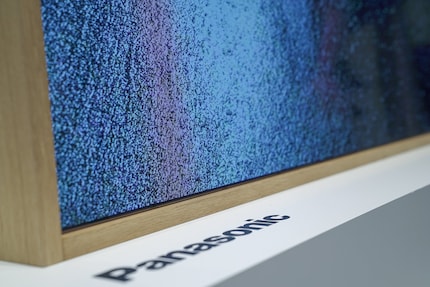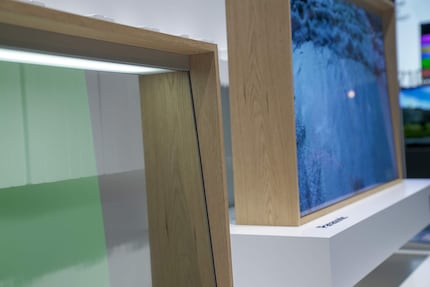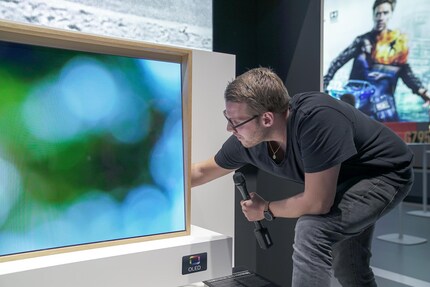
Product test
The exciting bit is when you turn it off: we put Samsung’s The Frame to the test
by Luca Fontana
At IFA in Berlin, Panasonic has revealed its first transparent OLED television and is dropping quite a bombshell: the TV is scheduled to be launched next year. We’ve had a sneak peek.
Dreams of the future? Well, yes, but: the near future. That’s what Panasonic's first transparent OLED television in the world promises. It’s expected to enter the market as early as 2020 – yes, next year. In Asia, that is. An official date for the start of sales in Europe hasn’t been announced yet.

This looks promising.
First of all: no, Panasonic didn't mention how much this transparent OLED TV will cost. They did, however, say this it wouldn't be low-priced. What exactly does that mean? Shrugging shoulders, turning heads...nobody wants to go out on a limb. What's clear is that Panasonic won't launch an OLED TV that only the upper class of Zurich's Gold Coast can afford. But students in their own shared flat – nope, they won't be able to afford this TV.

Having said that, most students probably can’t afford a conventional OLED TV – that’s if they don't have rich parents. Then who’s the TV for? Especially for all those who don’t like having a big black hole in their living room. Samsung has already tackled this problem. The Frame or the Serif TV are televisions that focus on design over picture quality.
Now Panasonic is following up with a TV that’s all about design. But not when it comes frame and stand, but when it comes to the screen. The OLED layer of this TV is transparent. In other words, when the TV is switched off, you can look straight through it. This is something the world has never seen. The TV world, that is.
An invisible panel? This begs the question of how black is created light can shine through pixels from both sides?
The answer is: it doesn’t shine from the back.

As Panasonic explained, the version presented at IFA is the third generation of this television. The question about light that I mentioned above was a problem with the two previous versions. A picture could be displayed, but it was semi-transparent at best. Nowhere near the image quality that makes UHD-HDR content stand out.

The solution has only recently been found: the transparent OLED panel, which, by the way, Panasonic produces itself, seals itself off on the back. What it does, basically, is switching to opaque. You may have seen this in a tram: some clear glass windows can turn into an opaque translucent when needed. This makes it possible to display black and thus a regular picture.
True black?
Nope. Nope. We're still quite a bit away from that, as a quick look at the picture reveals. The exact brightness and black values this TV will have once it's released are kept a secret. If Panasonic wants to launch this TV in Asia as early as next year, they'll have to start giving us facts soon.
By the way, the components such as processors and electronics are built into the wooden frame. Makes sense, as they’d be visible if the OLED panel is transparent. Clever people at Panasonic, right?
What Panasonic presented at IFA sounds like it's all still up in the air and won't be released for decades. But the future is closer than we might think: this TV is launched next year. And that means the prototype that was presented at IFA isn’t too different from the final product, making it all the more exciting.

In fact, the demo video looks good. Not as good as OLED typically does. Not true black. But still. Panasonic’s conventional OLED TVs are already making an impression on the market – more and more industry experts consider Panasonic OLEDs to be at least as good as the TVs produced by the South Korean competitors. These transparent panels could indeed be the next-generation technology that other major manufacturers have yet to build on.
I'm looking forward to what's about to come.
I write about technology as if it were cinema, and about films as if they were real life. Between bits and blockbusters, I’m after stories that move people, not just generate clicks. And yes – sometimes I listen to film scores louder than I probably should.
From the latest iPhone to the return of 80s fashion. The editorial team will help you make sense of it all.
Show all